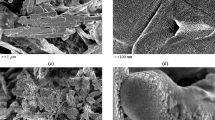Abstract
The detonation of nitromethane and a dinitrotoluene solution in bistrinitroxyethylnitramine when the diameter of the cylindrical charge is close to the critical was investigated with the aid of high-speed photography of the luminosity of the lateral and end cylinder surfaces and the recording of the spin wave surface using sampling plates with an air gap. It was discovered that the appearance of penetrating spinning absence-of-reaction waves, which are responsible for the attenuation of liquid explosive detonation, is closely related to the spread of detonation spin waves over the charge surface (or immediately below it). The spin waves, which are instrumental in the propagation of a normal detonation in weakly heterogeneous cast charges consisting of trotyl-hexogene and trotyl-PETN, in the case of liquid explosives probably inhibit the detonation process by inducing the formation of penetrating absence-of-reaction spin waves. It is shown that the spin wave velocity corresponds to the degree of material compression in the near-surface layer, as calculated according to the Dremin-Trofimov model (it can be only slightly above it.)
Similar content being viewed by others
Literature Cited
A. N. Dremin, “Critical diameter in the detonation of liquid explosives”, Dokl. Akad. Nauk SSSR,147, No. 4, 870 (1962).
A. N. Dremin and V. S. Trofimov, “Calculation of critical diameters in the detonation of liquid explosives”, Zh. Prikl. Mekh. Tekh. Fiz., No. 1, 126 (1964).
A. N. Dremin, S. D. Savrov, V. S. Trofimov, et al., Detonation Waves in Condensed Media [in Russian], Nauka, Moscow (1970).
J. W. Enig, and E. J. Petrone, “The failure diameter theory of Dremin,” Proc. Fifth Symp. (Int.) on Detonation, ACR-184, Office of Naval Res., Arlington, Va., p. 99 (1970).
V. N. Gamezo and B. N. Kondrikov, “Calculation of the critical decomposition characteristics of nitromethane and trotyl be means of the temperature dependence of the critical detonation diameter”, Proc. Fourth All-Union Conf. on Detonation in Telavi,1, 111 (1988).
V. N. Gamezo, G. D. Kozak, B. N. Kondrikov, et al., “Chemical reaction kinetics in the detonation of nitromethane salt with sulfuric acid,” in: Chemical Physics of the Processes of Combustion and Explosion. Chemical Reaction Kinetics., Proc. Ninth All-Union Symp. on Combustion and Explosion in Chernogolovka, p. 110 (1989).
G. D. Kozak, V. V. Kondrat'ev, B. N. Kondrikov, et al., “Propagation of detonation through a thin dangerously explosive material layer,” First All-Union Symp. on Macroscopic Kinetics and Chemical Gasdynamics, Chernogolovka,1, Part 2 (1984).
G. D. Kozak, B. N. Kondrikov, and V. N. Oblomskii, “Spinning detonation in solid materials”, Fiz. Goreniya Vzryva,25, No. 4, 86 (1989).
A. W. Campbell, T. E. Holland, M. E. Malin, et al., “Detonation phenomena in homogeneous explosives”, Nature,178, No. 4523, 38 (1956).
M. A. Sadovskii, “Mechanical action of air shock waves from explosions according to the experimental investigation data”, Fiz. Vzryva, No. 1, Izd. Akad. Nauk SSSR, Moscow (1952).
P. A. Urtiew and A. S. Kusubov, “Wall traces of detonation in nitromethane-acetone mixtures,” Proc. Fifth Symp. (Int.) on Detonation, ACR-184, Office of Naval Res., Arlington, Va., 105 (1970).
S. G. Andreev, V. S. Zhuchenko, V. V. Zyuzin, et al., “Longitudinal-transverse instability of accelerated initiating shock waves”, Fiz. Goreniya Vzryva,27, No. 1, 139 (1991).
P. A. Persson and G. A. Bjannholt, “A photographic technique for mapping failure waves and other instabiliting phenomena in liquid explosive detonation,” Proc. Fifth Symp. (Int.) on Detonation, ACR-184, Office of Naval Res., Arlington, Va., 115 (1970).
B. N. Kondrikov and A. I. Sumin, “Equation of state for gases at high pressures”, Fiz. Goreniya Vzryva,23, No. 1, 114 (1987).
Additional information
Moscow. Translated from Fizika Goreniya i Vzryva, Vol. 28, No. 2, pp. 93–98, March–April, 1992.
Rights and permissions
About this article
Cite this article
Kozak, G.D., Kondrikov, B.N. & Oblomskii, V.B. Spin wave and attenuation of liquid explosive detonation. Combust Explos Shock Waves 28, 195–199 (1992). https://doi.org/10.1007/BF00754860
Received:
Issue Date:
DOI: https://doi.org/10.1007/BF00754860



